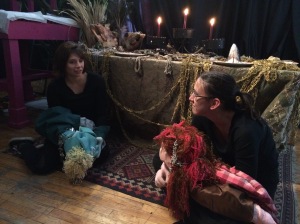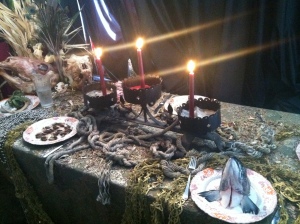I believe you learn a lot about your own art when you take on the challenge of teaching it to someone else. By figuring out how to explain the steps, hit the important rules but also allow for creativity and experimentation, you come to a better understanding of how an art form works and how to make better art. When I teach puppetry, I often fall back on styles and forms that are familiar and that I know are within the capability of the age groups I’m working with. Last spring, however, I was given an opportunity to do a puppetry residency with an entire grade level at a local public school and I decided to throw caution to the wind.

Second grade students at Bancroft Elementary drawing puppets for their projects.
I’ve been in love with the Brazilian style of puppetry called caja lambe-lambe ever since I first heard about it in Argentina three years ago. From my early flailing attempts, to slightly more sophisticated projects to interviews with my teachers, I’ve been exploring and experimenting with this form and trying to get better at it. I also want the style to become better known here in the US, as it is throughout most of Latin America. I wasn’t sure if three classes of second graders were quite ready to tackle developing a show, building it and performing it all in two months of art classes. However, they dived in with enthusiasm, eager to try it all.

Cutting out a puppet.
The hardest part of collaborative artwork for kids is usually decision-making and this project was no exception. As a teacher, I usually encourage my students to make compromises and find ways to incorporate ideas from everyone in the group. But with only three minutes to perform the entire show, some contributions had to be cut and choices made quickly. The students all began with choosing a poem, one of three by then-national Poet Laureate Juan Felipe Herrera. Most groups (somewhat predictably) chose the shortest poem, “Jackrabbits, Green onions and witches stew” which had a simple, bouncing cadence and a list of random fun objects. Several of the groups tried their very hardest to make puppets of every single thing mentioned in the poem, something I will try to discourage if I teach this workshop again. In the future, it would be interesting to give the students a wider range of story options, but I did like the way the project gave them a new way to explore poetry.

Painting the boxes was messy, but fun.
We discovered when the students began to work on their actual boxes that having four or five people painting the same box quickly gets messy. Using markers allowed for more flexibility, although it did take longer to complete. The most successful boxes included detailed drawing on both the inside outside of the boxes. Some groups painted a title on the front of the box and others added decorations around the peephole. They learned that the lid of the box would cover up the top inch of the sides and to take that into account when painting decorations. Color combinations were negotiated and compromises made when students ran out of one color or another.
Cardboard and paper were not the sturdiest materials to use in puppet making, and in retrospect, I should have given a little more explicit instruction on how to design and create the actual puppets. Working at that small scale is challenging for seven and eight year olds and their lack of experience meant that some puppets ended up being so tiny, it was hard to see them. I did give students the option of using clay, but that turned out to be too heavy for the pipe cleaners we were using for puppet controls. In the future, I would like to see what kind of small puppets the students can create using recycled materials, including fabric, plastic and wood.

Practicing a caja lambe-lambe show.
The most surprising and successful part of this experiment for me was the final presentation. Usually, caja shows are performed outside, or sometimes in a gallery space, where the audience walks around and watches them one by one. This is time-consuming, for both the audience and the performer and I was doubtful that second graders would be able to stay patient and wait their turn at each box. Likewise, I wanted to find a way to allow each member of the group to contribute to the performance, instead of having just one puppeteer. In order to save time and space, we came up with a solution involving technology–specifically, a document camera and projector. The lens of the document camera fit perfectly into the peephole, allowing us to project the view of the inside of the box onto a whiteboard for the entire class to see. One student read the poem aloud, while the others operated the little flashlights to light the inside of the box and the entrances and exits of puppets. The excited “Ohhhhhh!” of the class when the lights came on and the inside of the box was revealed was truly satisfying for everyone.

The view of the inside of the box, projected via a document camera.

Students working together to perform their caja lambe-lambe show.






































